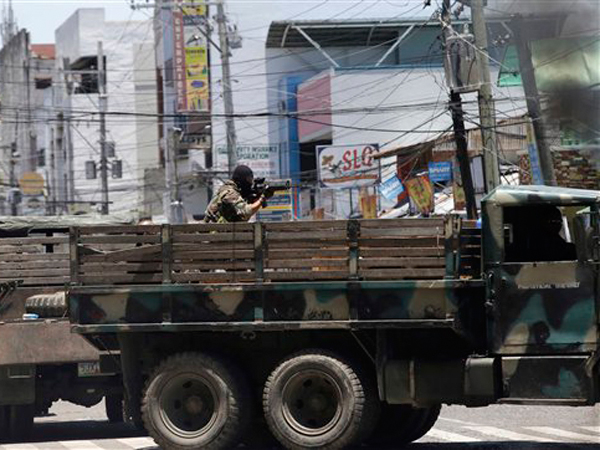
A government trooper aims his rifle as fighting continues with Muslim rebels Saturday Sept. 14, 2013 at Zamboanga city in southern Philippines. The Muslim rebels holding more than 100 people hostage in the southern Philippines exchanged gunfire with government troops Saturday despite efforts by the country’s vice president to arrange a cease-fire and end the six-day standoff. AP
ZAMBOANGA CITY – The Philippine military said Monday they were close to defeating Muslim rebels laying siege to this southern city, but the guerrillas defiantly traded gunfire while using civilians as human shields.
The military said up to 100 Moro National Liberation Front (MNLF) rebels were still engaged in battles with troops around two coastal villages in Zamboanga, a week after the guerrillas invaded the city to stake an independence claim.
“They still have ammunition and they continue to fire at us,” armed forces spokesman Lieutenant Colonel Ramon Zagala told AFP by phone from Zamboanga, but he insisted a military offensive was succeeding.
“We know for a fact that the end is near and they are trying to flee. Some of them may be trying to disguise as civilians, so it’s very critical that the village elders help us identify those who are not from their neighborhoods.”
Heavily armed MNLF forces entered the port city’s coastal neighborhoods last Monday in a bid to sabotage talks between a rival rebel group and the government that are aimed at ending decades of conflict.
Muslim rebels have been fighting since the 1970s for an independent or autonomous homeland in south of the mainly Catholic Philippines. An estimated 150,000 people have died in the fighting.
The latest violence in Zamboanga has left 51 MNLF fighters, six security forces dead and four civilians dead, according to Zagala.
The rebels initially took dozens of hostages and burned hundreds of homes, forcing a shutdown of Zamboanga, a city of about one million that is a key commercial hub in the region.
Zagala said the military was on Monday maintaining its offensive, which began on Friday, and the rebels were contained in two coastal villages.
“We are continuing to push forward today. This is a calibrated action that is steadily moving in a deliberate pace,” he said.
However he declined to give a timeframe for when the assault may end.
He said MNLF rebels torched a section of Santa Barbara, one of the neighborhoods, to slow down the military advance.
Volleys of gunfire could be heard ringing out across Santa Barbara, while sniper fire from the rebels prevented firemen from approaching the burning community, an AFP reporter said.
The military and police have said many of the hostages had been freed or escaped.
But Zagala said an undetermined number of villagers were still being used as “human shields” on Monday.
After its Philippine representative visited Zamboanga, the New York-based Human Rights Watch expressed concern for civilians trapped in the conflict.
As many as 300 civilians in one village had sought shelter in an ice plant building after abandoning their homes, while others had stayed behind to protect their belongings, it said.
Some residents told the rights monitor they feared that those left behind could be accused of being rebels.
Nearly 70,000 people have already fled the fighting, and international humanitarian agencies have rushed aid.
Classes as well as ferry and air services remained suspended for an eighth consecutive day in Zamboanga, as local businessmen warned of severe consequences to the local economy.
Zamboanga, about 850 kilometers (528 miles) south of the capital Manila, is a former Spanish fort during colonial times famous for its thriving barter trade with neighbouring countries.
Today it is a major industrial and trading hub for the south, while one of its most important economic sectors is a sardine-producing industry.
The MNLF waged a 25-year guerrilla war for independence before signing a peace treaty in 1996 that granted limited self-rule to the south’s Muslim minority.
MNLF founder Nur Misuari deployed the gunmen to Zamboanga after accusing the government of sidelining his group during negotiations for a separate deal with a rival rebel group.
The rival faction, the Moro Islamic Liberation Front (MILF), is in the final stages of peace talks with Manila and is aiming to take over an expanded autonomous Muslim region in the south by 2016.
The siege began after Misuari’s men went to Zamboanga to plant an independence flag.
Related Stories:
Zambo fighting enters second week
No end in sight for Zamboanga conflict
More gov’t troops sent to Zamboanga City to fight MNLF
Nearly 100 MNLF rebels killed or captured – officials